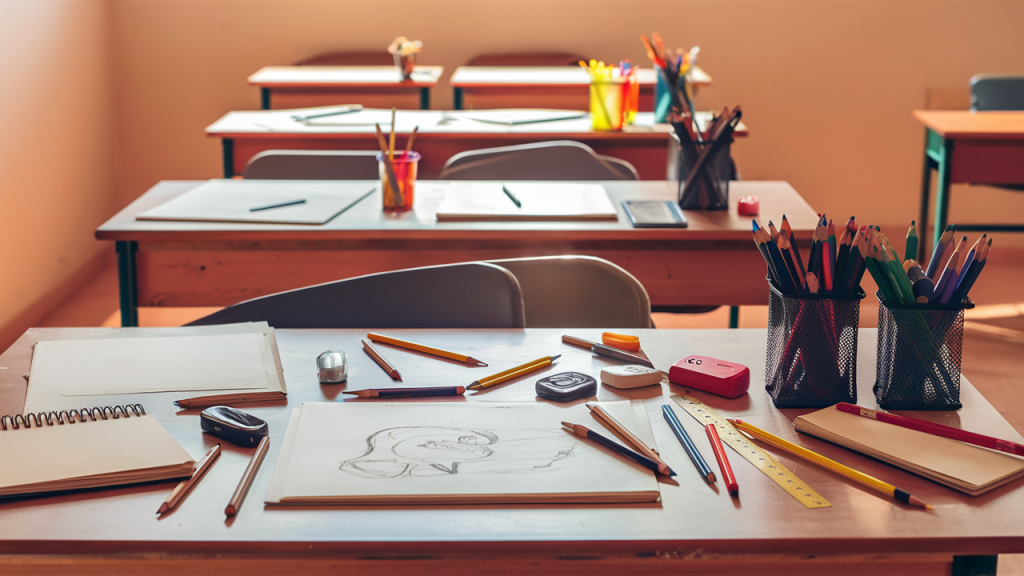Are you confused about which art supplies your middle schooler really needs? I’ve got you covered with this guide to the 10 must-have drawing tools that will set your child up for success.
In this article, you’ll discover exactly what to buy, why each item matters, and how to choose quality supplies without breaking the bank.
As an art teacher with 12 years of experience, I’ve seen firsthand which supplies actually get used and which collect dust. Trust me when I say this list contains only the essentials that middle school artists truly need.
Let’s dive in!
Introduction
Many kids really start to develop their artistic skills in middle school. Having the right tools makes a huge difference.
With good supplies, your child will feel more confident. Bad supplies can make even talented kids give up in frustration.
You don’t need to spend a fortune. The items on this list are affordable but effective. Let’s explore each one.
1. Pencils
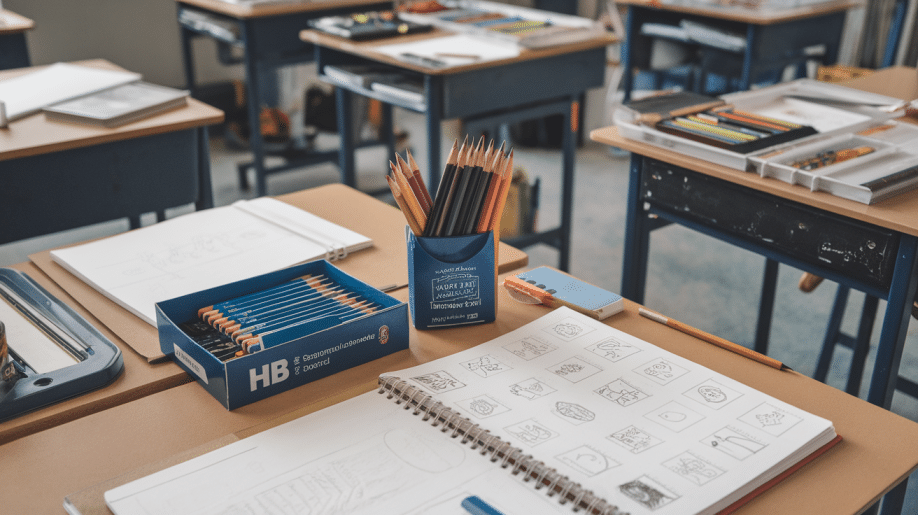
The humble pencil is the foundation of all drawing. It’s often the first tool young artists master.
Different Types of Pencils
There are three main types your middle schooler should know:
-
Graphite pencils come in different hardness levels (like 2B, HB, 2H). Softer pencils (B series) make darker marks and are great for shading. Harder pencils (H series) make lighter marks and are perfect for details.
-
Colored pencils let kids add vibrant colors to their work. They’re less messy than markers or paints.
-
Mechanical pencils keep a consistent line weight and never need sharpening. They’re great for precise line work.
A starter set with 2B, HB, and 2H pencils will cover most needs. For detail work, add a simple mechanical pencil with 0.5mm lead.
Why Pencils Are Important
Pencils allow your child to:
- Sketch lightly before committing to darker lines
- Create shading from very light to very dark
- Erase and correct mistakes easily
- Work with precision
I always tell my students that mastering pencil skills first makes learning all other art forms easier.
2. Erasers
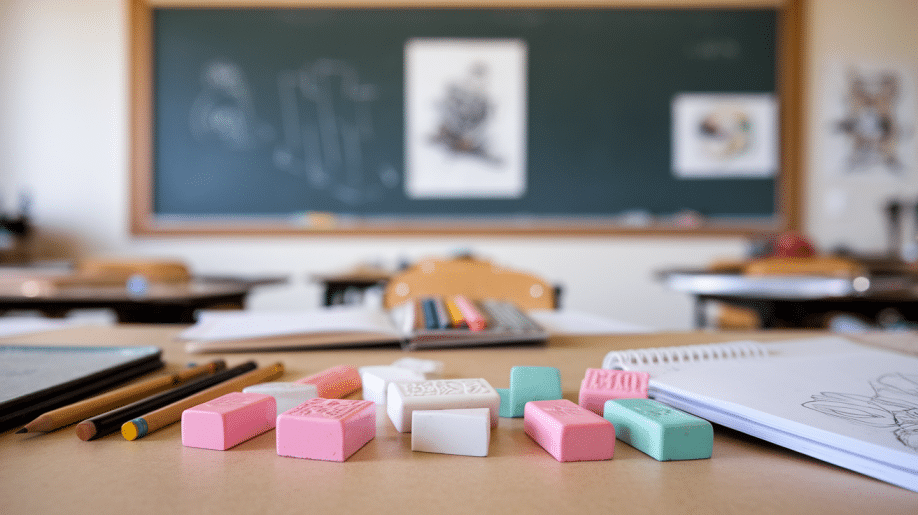
Mistakes happen. Good erasers are just as important as good pencils.
Types of Erasers
Your middle schooler needs at least two types:
-
Rubber erasers (the pink ones) are good for removing large areas of pencil.
-
Kneaded erasers can be shaped into points for precision erasing. They don’t leave crumbs and can be used to lighten areas by gently dabbing.
-
Precision tip erasers (like pen-style erasers) are great for tiny details and tight spaces.
Each type has its strengths. Having all three gives your child options for different situations.
Why Erasers Are Essential
Erasers aren’t just for fixing mistakes. They’re actually drawing tools!
With good erasers, your middle schooler can:
- Remove guidelines after completing a drawing
- Create highlights by erasing areas of shading
- Refine edges and shapes
- Experiment without fear of permanent mistakes
Learning to use erasers well is actually a skill. Many of my students discover that “drawing with the eraser” is just as important as drawing with the pencil.
3. Sketchbooks
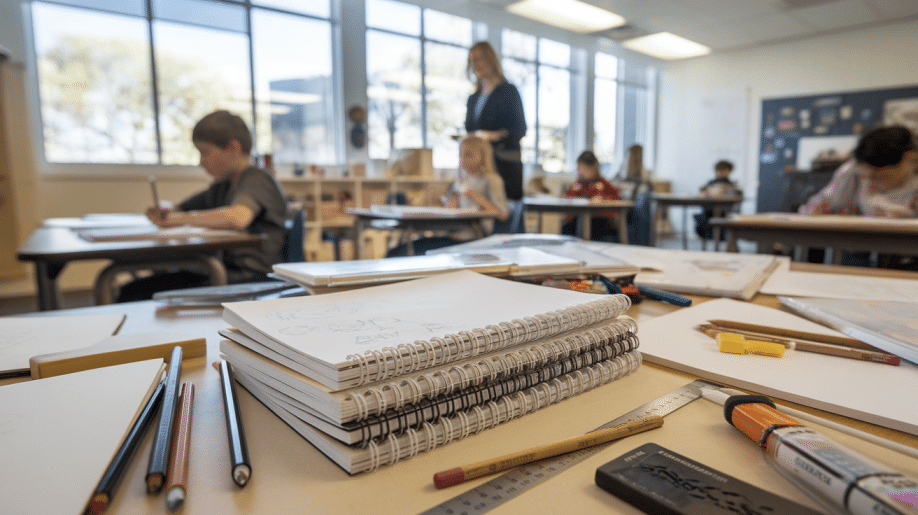
A dedicated place to draw makes a big difference in how often your child will practice.
Paper Quality
Not all paper is created equal. For middle schoolers, look for:
- Medium weight paper (70-90 lb) that won’t tear easily
- Slightly textured surface that grabs pencil well
- Acid-free paper that won’t yellow over time
Avoid:
- Very thin paper that tears or buckles
- Super smooth paper that makes pencils slide around
- Newsprint (it’s too fragile and discolors quickly)
The right paper helps pencils glide smoothly and allows for better shading. It also holds up to erasing without tearing.
Different Sizes of Sketchbooks
Size matters! For middle schoolers, I recommend:
- 8.5 x 11 inches for everyday drawing
- 5 x 7 inches for a portable option that fits in backpacks
Larger sketchbooks (11 x 14 inches) can be intimidating for beginners. That big blank page can cause “artist’s block”! Smaller pages feel more approachable.
Spiral-bound sketchbooks lay flat and are easier to use. Hardcover bound books last longer but don’t open as wide.
4. Colored Pencils

Colored pencils bridge the gap between drawing and painting. They’re clean, portable, and easy to control.
Variety and Vibrancy
There’s a huge range in quality:
- Student grade sets (12-24 colors) are affordable and good enough for beginners.
- Artist grade pencils have more pigment and blend better but cost more.
Brands like Crayola are fine for middle schoolers. As they advance, Prismacolor or Faber-Castell offer better quality.
Look for pencils that sharpen without breaking. Cheap colored pencils often have off-center leads that snap easily, which frustrates young artists.
Why Colored Pencils Are Great for Beginners
I love colored pencils for middle schoolers because they:
- Don’t dry out like markers
- Don’t need water or special paper like paints
- Can be layered to create new colors
- Allow for detailed work
- Don’t make a mess
The techniques learned with colored pencils (like blending and layering) transfer to other art forms later.
5. Markers
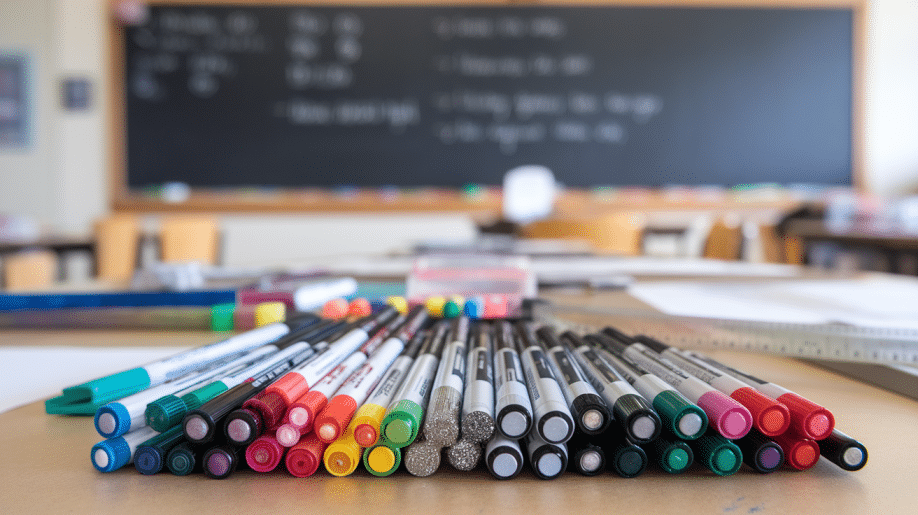
Markers create bold, bright artwork that middle schoolers love. Their vibrant colors really pop on paper!
Types of Markers
There are three main types to consider:
-
Washable markers are great for younger middle schoolers. They clean up easily from hands and most clothing.
-
Permanent markers (like Sharpies) work on many surfaces but won’t wash out. They’re better for older, more responsible students.
-
Fine-tip markers allow for detailed line work and are perfect for adding outlines to colored pencil drawings.
A set of 8-12 washable markers plus a few black fine-tip markers is a good starting point.
Benefits of Markers
Markers offer advantages that other media don’t:
- Bright, consistent color with no effort
- Quick coverage of large areas
- No drying time
- Bold outlines that make artwork pop
My students often combine markers with colored pencils for a mixed-media approach that looks amazing.
6. Charcoal
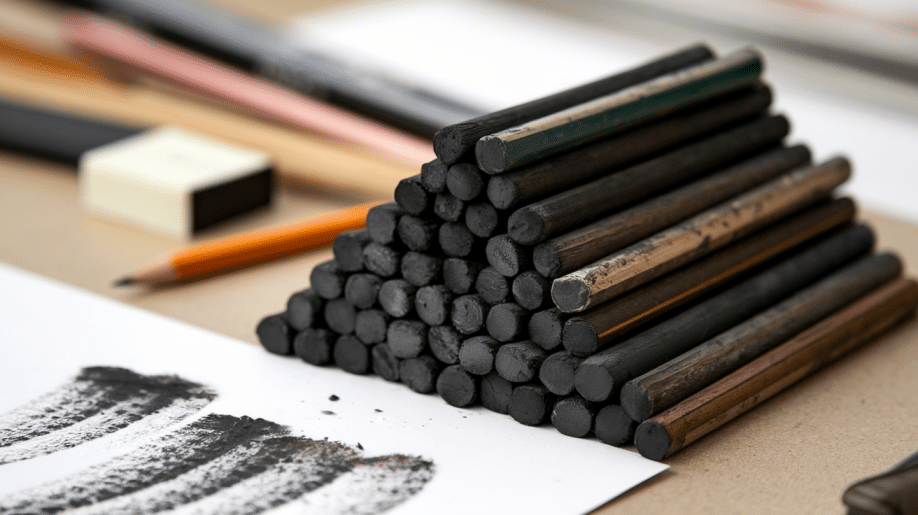
Charcoal creates rich, velvety blacks that pencils can’t match. It’s messy but fun!
Types of Charcoal
Start with these basics:
-
Soft charcoal creates the darkest blacks but smudges easily.
-
Medium charcoal balances darkness and control – good for beginners.
-
Hard charcoal gives more precision but lighter marks.
-
Charcoal pencils combine the richness of charcoal with the control of a pencil – perfect for middle schoolers!
A small set of charcoal pencils is the best starting point. Save loose charcoal sticks for when they have more experience.
Using Charcoal for Shading
Charcoal is amazing for creating:
- Deep shadows
- Dramatic contrasts
- Soft, atmospheric effects
- Textured surfaces
I find that middle schoolers who struggle with pencil shading often have breakthroughs with charcoal. It’s more forgiving and creates dramatic results quickly.
7. Pastels
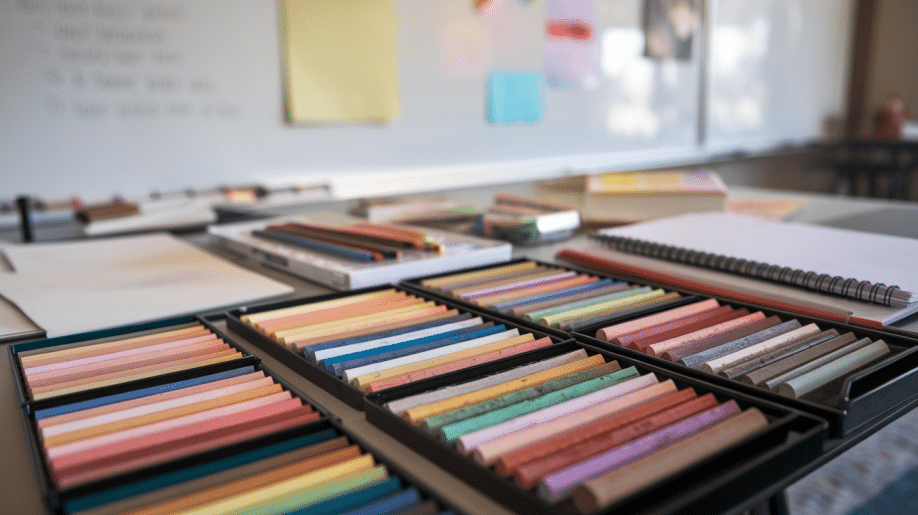
Pastels bridge the gap between drawing and painting. They’re like colored chalks that blend beautifully.
Oil vs. Soft Pastels
There are two main types:
-
Oil pastels are waxy, don’t create dust, and don’t need fixative. They’re more durable and less messy – better for most middle schoolers.
-
Soft pastels (chalk pastels) create beautiful blends but are fragile and create dust. They need spray fixative to preserve the artwork.
For beginners, a small set of oil pastels is the way to go. They’re more forgiving and less messy.
Pastels for Blending and Color Work
Pastels excel at:
- Creating smooth color transitions
- Building up rich, painterly effects
- Layering colors to create new shades
- Covering large areas quickly
I’ve noticed that students who get frustrated with the precision required for pencil work often love the freedom of pastels.
8. Rulers and Stencils
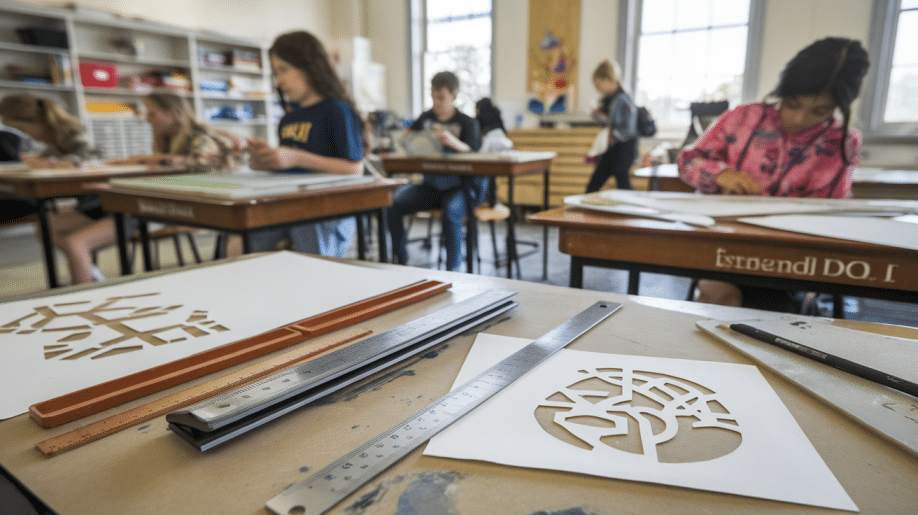
Even freehand artists need tools for precision sometimes.
Rulers for Precision
A good ruler is essential for:
- Drawing straight lines
- Creating perspective drawings
- Measuring proportions
- Making clean borders
Get a clear plastic ruler so your child can see through it to the paper underneath. A 12-inch ruler works well for most projects.
Stencils for Shapes and Design
Stencils help with:
- Creating perfect circles and curves
- Drawing consistent shapes
- Making patterns and designs
- Learning about geometric forms
A basic circle template and a French curve are useful additions to any drawing kit.
9. Pencil Sharpeners

A dull pencil makes drawing much harder. Good sharpeners make a big difference!
Manual vs. Electric Sharpeners
Both have their place:
Manual sharpeners are:
- Portable
- Never need batteries or outlets
- Allow control over sharpness
- Inexpensive
Electric sharpeners are:
- Fast and effortless
- Great for classroom settings
- Better for students with motor difficulties
- More expensive
A quality handheld sharpener with a case to catch shavings is perfect for most middle school artists.
Why Sharp Pencils Are Key
Sharp pencils allow for:
- Fine details
- Precise lines
- Better control
- Smoother shading
I tell my students that trying to draw with a dull pencil is like trying to write with a crayon – you can do it, but it won’t look great!
10. Blending Tools
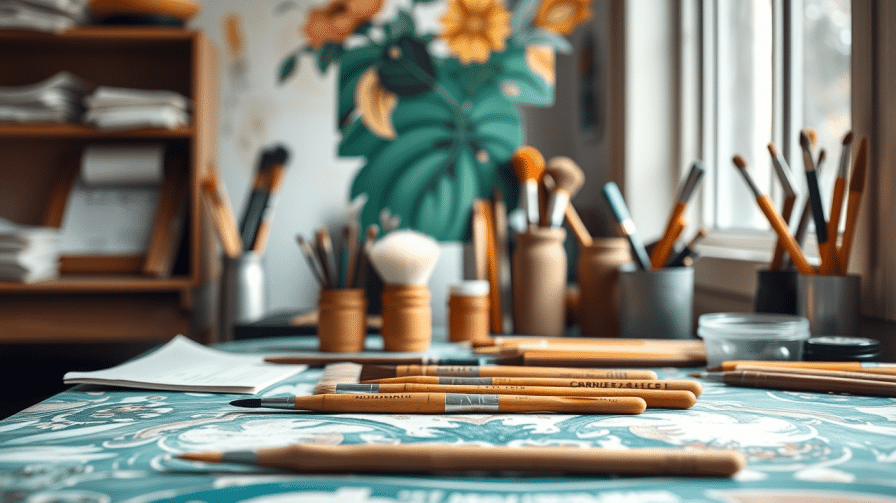
Blending tools take drawings to the next level by smoothing out shading and creating professional effects.
Tortillons and Stumps
These paper blending tools have slightly different uses:
- Tortillons are tightly wound paper points good for small areas.
- Stumps are softer and better for larger areas.
Both are inexpensive and reusable. They can dramatically improve the look of pencil and charcoal drawings.
How to Use Blending Tools Effectively
Simple techniques include:
- Rubbing lightly over shaded areas to smooth transitions
- Using the side for larger areas and the tip for details
- Cleaning the blending tool by rubbing it on scrap paper
- Using different blenders for different colors or media
I’ve seen countless “wow” moments when students use blending tools for the first time and see how professional their work suddenly looks.
Conclusion
These 10 essential supplies give middle school artists everything they need to explore drawing. Each tool opens up new possibilities and techniques.
Remember that quality matters, but you don’t need the most expensive options. Mid-range student supplies will serve your middle schooler well.
The most important thing is having a variety of tools to experiment with. Different supplies inspire different types of creativity.
Encourage your child to use these tools regularly. Practice is what turns supplies into skills!
Frequently Asked Questions
What is the best sketchbook for a beginner?
I recommend a spiral-bound sketchbook with 70-80 lb paper. The spiral binding lets the book lay flat, and medium-weight paper handles pencil, colored pencil, and light marker work.
Can middle schoolers use professional drawing supplies?
Yes, but it’s not always necessary. Professional supplies can offer better quality but cost much more.
What are the differences between soft and hard charcoal?
Soft charcoal makes darker marks but smudges easily and can be messy. Hard charcoal creates lighter marks but offers more control and less mess.
How often should drawing pencils be sharpened?
Regular graphite pencils should be sharpened whenever the point becomes dull, which might be several times during a drawing session.


